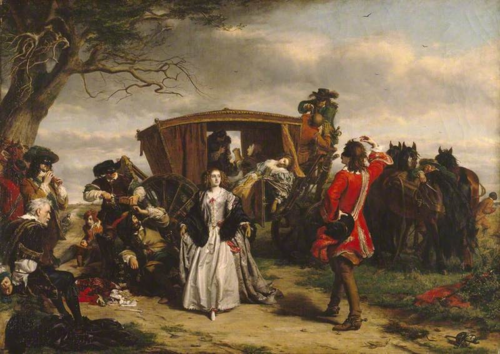Year 1670 Overview
1670 (MDCLXX) was a common year starting on Wednesday of the Gregorian calendar and a common year starting on Saturday of the Julian calendar. It represented the 1670th year of the Common Era (CE) and Anno Domini (AD) designations, the 670th year of the 2nd millennium, the 70th year of the 17th century, and the 1st year of the 1670s decade. As of the beginning of 1670, the Gregorian calendar was 10 days ahead of the Julian calendar, which continued to be used in some regions until 1923.
Events
January–March
January 17 – Raphael Levy, a Jewish resident of Metz, France, is burned at the stake after being accused of the ritual murder of a child. The prosecutor applies to King Louis XIV for an order to expel all Jewish families from Metz, but the king refuses.
January 27 – Aurangzeb, the Muslim emperor of the Mughal Empire, issues an order for the destruction of all Hindu temples and schools in India, including the Keshvadeva Temple in Mathura.
February 4 – The Battle of Sinhagad occurs in India, where the Maratha army, led by Tanaji Malusare, captures the Kondhana Fortress, although Tanaji is killed in the battle. The fortress is renamed Sinhagad, meaning “Lion’s Fort.”
February 9 – Christian V ascends as king of Denmark-Norway following the death of his father, Frederick III.
February 27 – The royal wedding of King Michal Wisniowiecki of Poland and Eleonore of Austria takes place at the Denhoff Palace.
March 7 – Oliver Plunkett, the Roman Catholic Archbishop of Armagh, returns to Ireland after 22 years due to a new policy of tolerance for Catholicism in England.
March 15 – The first English settlers arrive in modern-day South Carolina, constructing a settlement at Albemarle Point.
March 18 – Petar Zrinski, the Viceroy of Croatia, calls for rebellion against the Habsburg rulers. The uprising fails, and Zrinski is executed.
March 31 – The British warship HMS Sapphire is wrecked beyond repair when Captain John Pearce mistakenly believes he is fleeing from pirates, leading to his court-martial and execution.
April–June
April 18 – King Christian V of Denmark dismisses corrupt adviser Christoffer Gabel and appoints Peder Griffenfeld.
April 29 – After prolonged deliberation, the papal conclave elects Cardinal Emilio Albieri as Pope Clement X.
May 2 – The Hudson’s Bay Company is granted a royal charter in England, controlling a vast area of land in Canada.
May 23 – Cosimo III de’ Medici becomes the Grand Duke of Tuscany.
June 1 – King Charles II of England and King Louis XIV of France sign the Secret Treaty of Dover, ending hostilities between their kingdoms.
June 9 – The Maratha Empire under Shivaji attacks the Mughal-controlled territories in response to previous agreements.
June 10 – King Louis XIV issues an ordinance prohibiting trade in French colonies with any other nation.
June 15 – The first stone of Fort Ricasoli in Malta is laid.
July–September
July 11 – England and Denmark sign the Treaty of Copenhagen to strengthen their alliance.
July 18 – The Treaty of Madrid is signed, formally ending ongoing territorial disputes between England and Spain.
August 17 – A joint fleet from England and the Dutch Republic rescues Christian slaves and defeats Algerian pirates in the Mediterranean.
August 26 – The French Parliament enacts a uniform criminal code with the Criminal Ordinance of 1670.
Mid-August – Spanish frigates from Florida prepare to attack South Carolina but abandon the attempt due to stormy weather.
September 5 – William Penn and William Mead are acquitted of violating the Conventicles Act, leading to a landmark legal precedent.
October–December
October 3 – Chhatrapati Shivaji leads an attack on the British settlement in Surat, but the British successfully defend their fortress.
October 14 – Molière’s comedy Le Bourgeois gentilhomme is performed for the first time.
October 18 – The Battle of Kitombo in Angola results in heavy losses for the Portuguese military.
November 24 – Louis XIV inaugurates the construction of Les Invalides, a veterans’ hospital in Paris.
December 15 – Privateer Henry Morgan recaptures Santa Catalina Island, followed by capturing Fort San Lorenzo on December 27.
December 31 – John Narborough’s expedition departs Corral Bay, surveying the coast.
Date Unknown
- Stenka Razin begins a Cossack rebellion in Russia.
- The city of Niani, capital of the Mali Empire, is sacked by the Bambara people.
- French settlers arrive on the Petite Côte in modern-day Senegal.
Notable Births
- January 24 – William Congreve, English playwright (d. 1729)
- February 25 – Maria Margarethe Kirch, German astronomer (d. 1720)
- February 28 – Benjamin Wadsworth, American president of Harvard University (d. 1737)
- May 8 – Charles Beauclerk, 1st Duke of St Albans (d. 1726)
- May 12 – King Frederick Augustus I of Poland (d. 1733)
- June 22 – Eva von Buttlar, German mystic (d. 1721)
- July 18 – Giovanni Bononcini, Italian composer (d. 1747)
- November 15 – Bernard Mandeville, Dutch-born economic philosopher (d. 1733)
Notable Deaths
- January 3 – George Monck, 1st Duke of Albemarle (b. 1608)
- January 21 – Claude Duval, French-born highwayman (b. 1643)
- February 9 – King Frederick III of Denmark (b. 1609)
- March 15 – John Davenport, Connecticut pioneer (b. 1597)
- May 23 – Ferdinando II de’ Medici, Grand Duke of Tuscany (b. 1610)
- June 30 – Henrietta, Duchess of Orléans (b. 1644)
- August 24 – William Neile, English mathematician (b. 1637)
- November 15 – Comenius, Czech writer (b. 1592)
References
Information sourced from historical records and prior research.

